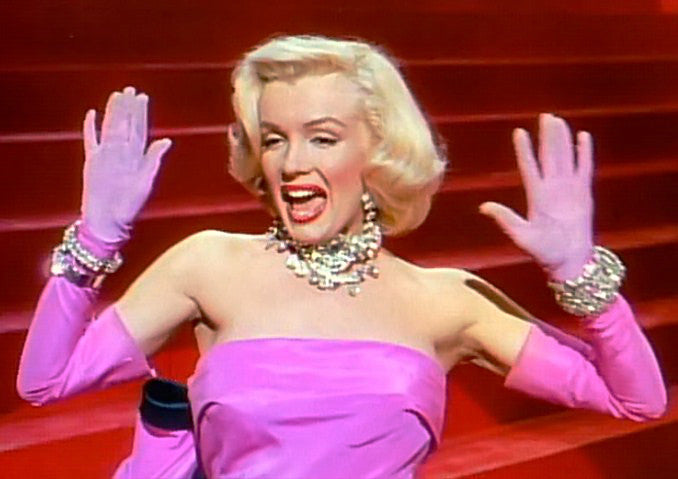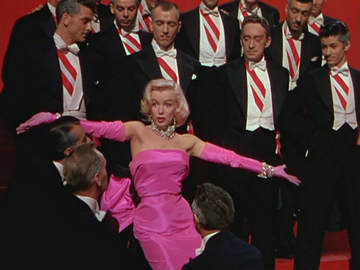
DIAMONDS! PART 3 - THE 4 C'S AND SOME SCIENCE!
Share

DIAMONDS!
THE 4-C'S AND THE SCIENCE!
Welcome to part 3 of the 3-part Diamond Series from Firefly Jewelry Studio!
They're more than just April's Birthstone!
So Marilyn never sang the praises of Diamonds because of their crystalline structure, or how hard they are...... or did she? Diamonds are exceptionally hard, have many uses beyond personal display, and are gorgeous.... They have value because of these qualities, and her character in Gentleman Prefer Blonds sure was talking about the $$$!!! So why are they so valuable and how do we rate that value?
A little science lesson....

Rough Diamonds in a Miners Hand
|
Diamonds are a solid form of the element Carbon. Carbon is transformed into Diamonds under intense pressure and heat, and on Earth, this compression can only happen deep below the Earth’s crust in the Mantle. Billions of years ago, these natural Diamonds were formed deep within the earth and later carried up to the surface by volcanic and tectonic activity to be later discovered in what are called Deposits. These deposits are made of igneous rock that has been named for the areas they were discovered such as Kimberlite from the town of Kimberley, in South Africa.
|
Diamonds are considered to be one of the hardest and most durable gemstones, and are the basis of the Moh’s Scale of Mineral Hardness, listed at a 10. The scale was created in 1812 by Friedrich Mohs, a German Geologist, and was based upon the ability for each mineral to scratch other minerals, and at the time it was developed the Diamond was the hardest known, and thus listed the top of this scale’s reference point. The scale runs from 1 to 10, Talc being the softest mineral and Diamond the hardest. And while it isn’t a representation of the hardness of each mineral in exact increments from 1 to 10, his scale is incredibly useful for jewelers, gemologists, and geologists alike to determine the durability of a gemstone in their relative applications.
 Jeweler Setting a Pink Diamond Jeweler Setting a Pink Diamond |
Their hardness also makes it easy to polish them to an extremely high luster. When cut, the Diamond’s edges become crisp and clean and then when polished the surface will become extremely reflective. This hardness also allows for more detail when cutting, which means more facets can be cut into a gemstone without worry of the integrity of the stone being damaged. More facets mean more reflective surfaces, which means MORE SPARKLES! And don’t we all want our gemstones to sparkle as much as possible?? There are exact mathematical equations developed by gemstone cutters to up the amount of facets/reflective surfaces versus the angle of cutting to catch the light and get the most sparkle out of each gemstone!
|
|
Diamonds can be found in every color of the rainbow depending on the impurities included in the make up of the stone. The internal lattice structure of a Diamond acts almost like a net, catching other minerals and trapping them by bonding to them. Brown and Yellow diamonds are the most common, and Red are the most rare.
|

|

Light shining into a Diamond
|
Some Diamonds also have the ability to do something called Fluorescing. Each stone has the ability to catch and use the UV rays in sunlight in some way. Some more than others, which is why some gemstones positively glow from within in the sun and you can spot them from across the room! Some glow so much that they look like your teeth do when walking under the black light at da Club! Some years back it was considered to knock the value of the Diamond down if it was found that a Diamond would fluoresce, but in recent years it has been agreed upon by most gemstone suppliers that fluorescing won’t devalue the stone unless the stone is already in the whitest colors, and in fact, can add to the value of darker, more brownish-yellow colored Diamonds.
|
 |

|
Most of us have heard of the 4 C’s but for those that haven’t or need a refresher, here they are:
Cut, Clarity, Color and Carat.
- Brilliance - or the brightness of the stone.
- Scintillation - the sparkle.
- Fire – when the light reflecting out of the stone can appear in a rainbow of colors.

Faceted Diamond Diagram
|
These facets should be as symmetrical as possible and the big top facet on the up-side of the stone, called the Table, should be parallel with the ring around the middle of the stone, called the Girdle, and face directly up. The smaller facets surrounding this Table cut and underneath the Girdle should be a series of diamond and triangle shapes and they should be symmetrical too. And the ratio of stone above the Girdle shouldn’t be too much or too little. Sadly, this isn’t always the case and can be found easily when choosing lower quality Diamonds. After you see a few in succession it will become painfully obvious when a stone isn’t cut very well, and you will be able to make your own decisions about whether that stone is one of quality. But if you are still not sure, when graded the Diamonds receive a Cut Grade and are rated from Excellent, through Very Good, Good, Fair, to Poor. Even when the Color and Clarity of the stone is considered excellent, if the Cut is poor the stone will be painfully boring in its appearance.
|
|
If you look deep inside a Diamond with magnification, there is a fingerprint of its history and how it was formed. Tiny birthmarks, or Inclusions occur in almost all Diamonds, and the term Clarity refers to how many of these Inclusions are actually present in each stone. Since most Diamonds will have at least a wisp of imperfection, cutters who are trained well will try to cut the stone in such a way that orients these imperfections in a location of the cut itself, where they cannot be easily seen, especially with the naked eye. The GIA Diamond Clarity Chart will list the finished Diamonds as so:
|

Diamond with Loop: This is the little magnifying glass Jewelers and Gemologists use to see inside gemstones
|
- Flawless (FL) - No inclusions or blemishes are visible to a skilled grader using 10× magnification
- Internally Flawless (IF) - No inclusions and only blemishes are visible to a skilled grader using 10× magnification
- Very, Very Slightly Included (VVS1 and VVS2) - Inclusions are difficult for a skilled grader to see under 10× magnification
- Very Slightly Included (VS1 and VS2) - Inclusions are minor and range from difficult to somewhat easy for a skilled grader to see under 10x magnification
- Slightly Included (SI1 and SI2) - Inclusions are noticeable to a skilled grader under 10x magnification
- Included (I1, I2, and I3) - Inclusions are obvious under 10× magnification and may affect transparency and brilliance

- D is the brightest white/colorless you can get and the Colorless gradient goes from D-F.
- G-J is considered Near-Colorless
- K-M is a faint bit of color towards the yellow spectrum.
- N-R is a very pale yellow.
- S-Z is a light yellow, though to me, the Z rating is truly a beautiful lemony yellow color.


|
A Carat is the unit of weight that gemstones are measured with. Not to be confused with Karat – which is the measurement of Gold Purity, or Carrots – which are the pointy orange roots preferred by bunnies the world over. The name originates from the original unit of measure by gemstone and Diamond dealers, a Carob Seed. Carob seeds were quite uniform in weight and early gem traders could use them for counterweights in their scales to get a fairly relative measurement. In 1913 our modern metric carat was adopted by the USA and the standard spread to the rest of the world. A carat is equal to .2 grams, about the same weight as a regular paperclip.
|

Diamond Engagement Ring - some consumers think that weight is the most important factor in choosing a stone. Do you agree?
|
Conflict-Free.
Please read about this important topic on my previous post here.
So, that's it for this month and our tour around April's Birthstone! I hope you've been enjoying this 3-part trip around the history and science of this magnificent gemstone! While they have a dark side, Diamonds are beautiful, durable, can be sourced sustainably, and are utterly fascinating! Keep a look out for some new Diamond Jewelry coming soon from Firefly Jewelry Studio! It promises to be Illuminating!
Until next time.....
An important note about Conflict-Free Diamonds and Firefly Jewelry Studio:
Firefly Jewelry Studio is committed to using Conflict–Free Diamonds and supports the practices of recycling Diamonds as well. I try to source my stones from Canada first, and when these stones are not available I make sure that my supplier can trace the origins of my Diamonds to a Conflict-Free region of this earth, or that the Diamond is recycled and ready for resale.



